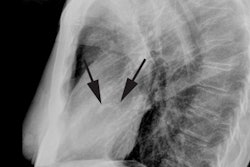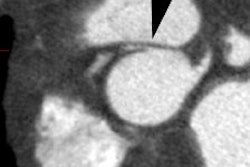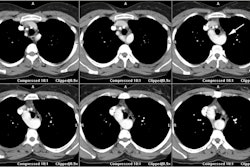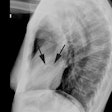Patent Ductus Arteriosus:
Clinical:
The ductus arteriosus represents the distal portion of the sixth embryonic aortic arch. In utero, the ductus permits a pulmonary-systemic connection for bypassing the high-resistance lungs [2]. Normally, the ductus closes functionally between 18-24 hours after birth (anatomic closure occurs at one month of age) [2]. If it remains patent at 3 months of age, it is considered a PDA [3]. A PDA accounts for about 10% of congenital heart disease and females are affected more than males (2 to 4:1). The condition is associated with prematurity (likely due to persistent post natal hypoxia [3]), Down's syndrome, maternal rubella syndrome, and other chromosomal abnormalities (4p syndrome, Carpenter syndrome, Holt-Oram syndromem and incontinentia pigmenti) [3]. If the ductus arteriosus remains patent, blood will be shunted from the aorta to the left pulmonary artery. The LA & LV thus handle an increased volume of blood. Right ventricle is not involved. If long standing, pulmonary arterial HTN may develop and result in shunt reversal (Eisenmenger physiology).Prostaglandin E1 is sometimes used to keep the ductus open in patients with certain cyanotic congenital heart diseases and indomethacin is used to close the ductus in premature infants (if there are no contraindications such as an intracranial hemorrhage) [2].
On exam there is a widened pulse pressure (due to diastolic siphon of blood into the pulmonary circulation). The lesion may cause CHF in premature infants due to natural history- ductus will initially close shortly after birth, however due to poor oxygenation in the underdeveloped lungs, it will reopen about day 5-7 with rapid overload. Associated cardiac anomalies include: VSD, coarctation of the aorta/hypoplastic aortic arch, and pulmonic stenosis.
X-ray:
Patients with small PDA's have a normal CXR. With moderate to large PDA's there is shunt vascularity, LAE, and LVE coupled with enlargement of the transverse portion of the thoracic aorta. Patients with PDA's tend to preferentially shunt blood to the right lung so the pulmonary vascularity may appear asymmetric.Images:
Case 1: Patent Ductus Arteriosus (Case submitted by Dr. Scott Flamm, Cleveland Clinic Foundation)REFERENCES:
(1) Pediatric Clinics of North America 1999; Driscoll DJ. Left-to-right
shunt lesions. 46(2): 355-368
(2) Radiology 2008; Lee EY, et al. Multidetector CT evaluation of congenital lung abnormalities. 247: 632-648
(3) Radiographics 2010; Kimura-Hayama ET, et al. Uncommon congenital and acquired aortic diseases: role of multidetector CT angiography. 30: 79-98






